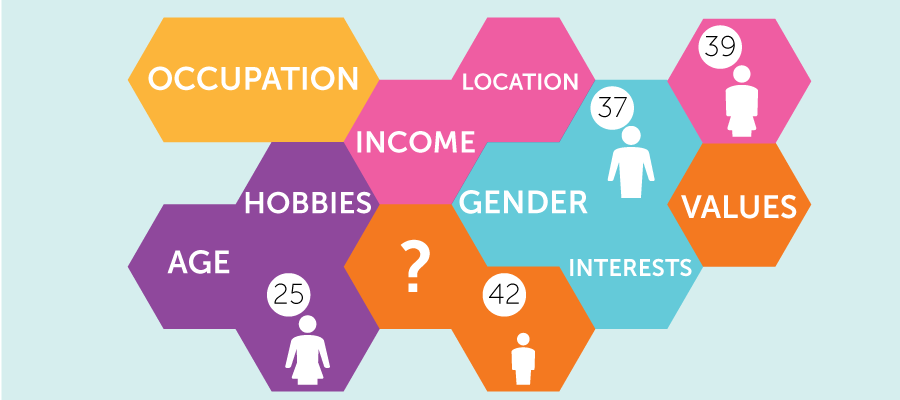
Discover Your Ideal Target Audience: The Step-by-Step Guide
Do you know who your ideal customer is? If not, don’t worry – this blog post will teach you how to find your target audience or target group (TG). It can be difficult to figure out who your target audience is, but it’s essential if you want your business to succeed. In this step-by-step guide, we will walk you through the process of discovering your ideal audience. By the end, you’ll have a clear idea of who you should be targeting with your marketing campaigns!
Definition of Target Audience
- Definition: The specific group of people that a company or organization aims to reach with its products, services, or marketing campaigns.
Importance of Identifying the Target Audience
It is important to know your ideal customer because this allows you to better target your marketing and advertising efforts. By understanding who your ideal customer is, you can create messaging that resonates with them and speaks to their specific needs and interests. Additionally, knowing your ideal customer can help you to identify where they are spending their time online and offline, so that you can reach them through the channels that they are most likely to use.
Importance of Identifying the Target Audience:
- Efficient Marketing: Understanding your target audience helps you tailor your marketing efforts to reach the right people, increasing the efficiency and effectiveness of your campaigns.
- Personalized Messaging: By knowing your target audience, you can create messages that resonate with their needs, preferences, and values, increasing the chances of engagement and conversion.
- Improved Product Development: Identifying your target audience allows you to gather insights and feedback that can be used to improve existing products or develop new ones that meet their specific needs.
- Enhanced Customer Experience: By understanding your target audience’s preferences and behaviors, you can deliver a more personalized and relevant customer experience, fostering loyalty and satisfaction.
Examples of Target Audience by some popular brands
Certainly! Here are some real examples of target audience matching to businesses:
- Nike: Target Audience – Athletes and Fitness Enthusiasts: Nike’s target audience consists of athletes and fitness enthusiasts who value high-quality athletic gear and apparel. Through their marketing campaigns, they emphasize performance, motivation, and empowerment, resonating with individuals who are passionate about sports and fitness.
- Apple: Target Audience – Tech-Savvy Individuals and Creatives: Apple’s target audience includes tech-savvy individuals who appreciate sleek design, user-friendly interfaces, and seamless integration between devices. They also cater to creatives, such as designers and artists, by offering specialized tools and software for creative work.
- Starbucks: Target Audience – Coffee Lovers and Urban Professionals: Starbucks targets coffee lovers and urban professionals seeking a premium coffee experience. Their stores often serve as meeting places for professionals, offering a cozy and comfortable environment. Starbucks appeals to those who enjoy the ambiance and the convenience of grabbing a high-quality coffee on the go.
- Airbnb: Target Audience – Travelers and Adventurers :Airbnb’s target audience comprises travelers and adventurers seeking unique and authentic travel experiences. They cater to individuals who prefer staying in local homes or accommodations with character, enabling them to immerse themselves in the culture and lifestyle of their destination.
- LEGO: Target Audience – Children and Parents: LEGO targets children as their primary audience, providing them with building sets and imaginative play experiences. They also appeal to parents who recognize the educational and developmental benefits of LEGO toys, emphasizing creativity, problem-solving, and STEM learning.
- Peloton: Target Audience – Fitness Enthusiasts and Busy Professionals: Peloton’s target audience includes fitness enthusiasts who value convenience and the ability to exercise from home. They also appeal to busy professionals seeking efficient and effective workout options. Peloton offers interactive fitness equipment and virtual classes that cater to these needs.
These are just a few examples of how businesses align their target audience with their products or services. Understanding the specific needs, desires, and preferences of their target audience allows companies to effectively tailor their marketing strategies and offerings to attract and engage the right customers.
Please note: The examples provided are based on general observations and may evolve over time as businesses adapt their marketing strategies and target audience profiles.
How can you discover who your ideal customer is?
There are a few key ways that you can discover who your ideal customer is. The first step is to think about what your product or service offers and who would benefit the most from it. Once you have a general idea of your target market, you can start to narrow down your ideal customer by considering factors such as age, gender, location, interests, and income level.
One of the best ways to get to know your ideal customer is to create buyer persona profiles. This involves developing fictional characters that represent your ideal customers based on real data and research. You can then use these buyer personas to guide your marketing and sales strategies.
Another great way to learn about your ideal customer is to simply ask them! Conduct surveys, interviews, and focus groups with current and potential customers to get feedback about their needs and wants.
How to Track and Target Your Target Demographic for Better Marketing
If you’re looking to market your product or service to a specific demographic, it’s important to first understand who your target audience is. What are their needs and wants? What are their interests and hobbies? Once you have a good understanding of your target demographic, you can start to tailor your marketing efforts to specifically appeal to them.
This may involve creating targeted ad campaigns, developing custom content, or providing special offers and discounts. By taking the time to stalk your target demographic, you’ll be able to develop a more effective marketing strategy that will ultimately lead to better results.
It is the Holy Grail of digital marketing to have a complete understanding of the buyer. You want to know everything about the buyers in your domain of business. It is important to gather that info because it opens up your eyes to a whole new range of parameters that you have probably not ticked yet. Studying the competition or SEO competition research and the competitors achieve that result to an extent but ultimately it is the buyers you need to study. Every domain in the digital marketing arena is dynamic and if you want to stay ahead of the competition curve, you cannot follow the competition and then think of surging ahead.
A trusted and tested way to move ahead is by stalking your customers and the target demographic. If you have an idea of how these buyers spend their time online, you will be in a better position to reach them. Your marketing efforts will be more targeted and specific. It will cut down on wastage and become more effective.
Thanks to a clutch of online tools, you can actually get all the info you need to build up an online persona for a small sample of potential buyers. Of course, you cannot do that for a group of 100, but surely you can track the online footprints of a group of 5. Once you do that, you can use the lessons to tailor your marketing overtures for better penetration.
One of the most important aspects of any business is understanding its target demographic. Without this information, it can be difficult to create effective marketing campaigns that reach the right people. In this blog post, we will discuss how to track your target demographic and use that information to improve your marketing efforts. We’ll also provide some tips on how to target your audience more effectively. Let’s get started!
Track Social Media Presence
The ideal way to do that is to identify buyers in your domain of business. Pick up a group of 5 from your list of buyers or from the social media pages of your competitors. Once you have 5 names, track their online footprints. Find out what kind of social media networks they frequent, what kind of content they share, which websites they like and what they usually talk about.
This is not a breach of privacy because all of this info is available in the public domain. You need to dig it out and use to your advantage. For example, a tool like Followerwonk on Twitter will give you enough about a user’s Twitter presence to build up their online profile.
Track Search Engines
The next logical step in this process is to look at search engine data. When these users search for content online, what kind of keywords they use. You can use a bit of hypothesis in guessing the keywords, based on the persona that you have developed from their social media data.
Related reading: how to do keyword research
Digital marketing is a lot of psychology as well, so you have to do some mind-reading at some point! Once you have a list of keywords, find out the domain names that these searches head for. You will get some domain names which are consistently present across the keywords. These are websites that are popular among your potential buyers.
Carry out Surveys
Now that you have gathered everything you want through public domain investigations, it is time to approach some of them individually and ask for their ideas. Surveys carried out on your sample group will be useful. You can broaden up your sample for this purpose.
Use forms that are simple, like the ones you find on Typeform. These have a higher completion rate and more people are likely to participate when the form is easy to fill up. You can pick up some email ids in the process and use them for networking with them later on.
Look for Marketing Openings
With all the popular websites and online haunts of your potential buyers identified, you need a presence in these places to be noticed. You have to look out for marketing openings and possibilities in these popular zones. Can you place ads on those popular websites or publish a guest blog post in a blog that is a rage these days? You need to figure out a way in which you can strike marketing gold by being visible at the very places where your preferred online crowd hangs out. If the people are not coming to you, you have to go out to them!
What are some common mistakes businesses make when trying to identify their target audience?
Some common mistakes businesses make when trying to identify their target audience are not doing enough research, not being specific enough, and not thinking about who their ideal customer is.
Not doing enough research is a mistake because you need to know who your target audience is before you can start marketing to them. You need to know what their needs are, where they spend their time, and what they’re interested in.
Not being specific enough is also a mistake because you need to be clear about who your target audience is. Otherwise, you’ll end up marketing to everyone and no one will be interested in what you have to say.
Not thinking about who your ideal customer is another mistake businesses make when trying to identify their target audience. You need to think about who your ideal customer is and what they want from your product or service. By doing this, you’ll be able to create a more targeted marketing campaign that will reach the right people.
How can you use your ideal customer profile to improve your marketing campaigns?
If you know who your ideal customer is, you can improve your marketing campaigns in several ways.
First, you can target your advertising more effectively. You can use the demographic information from your ideal customer profile to narrow down where to place your ads and what kinds of ads to use. For example, if you know that your ideal customers are women aged 25-34 who live in urban areas, you can target your ads accordingly.
Second, you can tailor your marketing messages to appeal more specifically to your ideal customers. If you know what kinds of things they care about and what their pain points are, you can craft messages that address those needs directly. This will make your marketing more effective and help you attract and retain more customers.
Third, you can use your ideal customer profile to improve your customer service. If you know who your ideal customers are, you can train your staff to be better prepared to serve them. This includes things like knowing what kinds of questions they might have, what their needs are likely to be, and how best to meet those needs. By providing better customer service, you’ll keep more customers happy and coming back for more.
Fourth, you can use your ideal customer profile to help inform product development decisions. If you know what kinds of products or features your ideal customers are looking for, you can develop products that appeal directly to them. This will help ensure that your products are well-received by the people who matter most to your business.
By taking the time to learn about their ideal customers and using that information wisely, businesses can improve their marketing campaigns in a variety of ways that will ultimately lead to more sales and happier customers.
What are some other benefits of knowing your ideal customer?
Some of the other benefits of knowing your ideal customer are that you can better target your marketing efforts, improve your chances of making a sale, and build better relationships with your customers. By understanding who your ideal customer is, you can identify what they need and want, and then create content and offers that appeal to them specifically. This helps to ensure that your marketing messages are relevant and that you are more likely to make a sale when you do connect with a potential customer. In addition, when you know your ideal customer well, you can build stronger relationships with them by providing the best possible experience and meeting their needs.
10 Best Steps to find out your target audience
To find your target audience for better marketing, consider the following pointers:
- Market research: Conduct thorough market research to identify demographic information such as age, gender, location, income level, and occupation that aligns with your product or service.
- Analyze customer data: Utilize customer data from your website analytics, CRM systems, or social media platforms to gain insights into the characteristics and behaviors of your existing customers.
- Create buyer personas: Develop detailed profiles of your ideal customers or buyer personas. Include information about their demographics, interests, pain points, motivations, and purchasing behavior.
- Competitor analysis: Analyze your competitors’ customer base to understand who they are targeting and how. Identify gaps or opportunities within their strategies that you can capitalize on to reach a different segment.
- Social media listening: Monitor social media conversations, forums, and online communities related to your industry or niche. This helps you understand what potential customers are talking about, their needs, preferences, and pain points.
- Conduct surveys and interviews: Engage with your existing customers or target audience through surveys or interviews. Ask questions to gather insights about their preferences, challenges, and motivations.
- Utilize audience targeting tools: Take advantage of digital advertising platforms that offer audience targeting capabilities. Use features like interest-based targeting, lookalike audiences, or demographic targeting to reach specific groups.
- Engage with influencers: Identify influencers in your industry or niche who have a similar target audience. Collaborate with them to reach their followers and gain exposure to your target market.
- Test and analyze: Continuously test different marketing strategies and channels to identify which resonate best with your target audience. Analyze the results and adjust your approach accordingly.
- Refine and iterate: Keep refining your understanding of your target audience based on ongoing research, feedback, and data analysis. Consumer behaviors and preferences evolve, so it’s important to stay up-to-date.
Remember, defining your target audience is an ongoing process. Regularly revisit and update your understanding of your target audience to ensure your marketing efforts remain effective and relevant.
Some useful tools for finding your target audience online
Here are some useful tools for finding your target audience online:
- Google Analytics: Provides valuable insights into website traffic, user demographics, behavior, and interests. It helps you understand who is visiting your site and how they interact with it.
- Facebook Audience Insights: Enables you to gain comprehensive data about Facebook users, including demographics, interests, behaviors, and purchase intent. It helps refine your targeting for Facebook ads.
- Twitter Audience Insights: Provides demographic information about your Twitter followers, such as interests, professions, and locations. This tool helps you understand and engage with your Twitter audience effectively.
- LinkedIn Audience Insights: Offers detailed information about LinkedIn users based on job titles, industries, company sizes, and more. It helps you identify and target professionals in specific fields.
- SEMrush: A comprehensive digital marketing tool that allows you to analyze competitors, perform keyword research, and gain insights into audience behavior and interests.
- Buzzsumo: Helps identify trending content and popular topics related to your industry. It allows you to uncover valuable insights about what resonates with your target audience.
- Quora: A platform where users ask questions and provide answers. By exploring relevant topics and discussions, you can gain insights into the questions and concerns of your target audience.
- Google Trends: Shows search popularity and interest over time for specific keywords or topics. It helps you identify trending topics and understand what people are searching for.
- SurveyMonkey: Enables you to create and distribute surveys to gather feedback from your target audience. It helps you understand their preferences, needs, and opinions.
Remember, these tools can provide valuable insights, but it’s essential to use them in conjunction with other research methods and data sources to develop a comprehensive understanding of your target audience.
Conclusion
There are a few different ways that you can track your target demographic. One method is to use customer surveys. You can either include a survey with every purchase or send out periodic emails asking customers about their demographics. Another option is to use data from social media platforms like Facebook and Twitter. This data can be used to create marketing campaigns that are targeted to specific demographics.
Once you have a good understanding of your target demographic, you can start to create more effective marketing campaigns. One way to do this is to segment your audience into different groups based on their demographics. This will allow you to create targeted messages that are more likely to resonate with each group.
You can also use this information to create custom landing pages and email campaigns. If you’re not sure where to start, consider hiring a marketing agency that specializes in target demographic research.
Learning the online graphs of consumers will put you in a better position to earning their trust and business.








This topic is really interesting